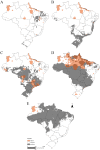Pet snakes illegally marketed in Brazil: Climatic viability and establishment risk
- PMID: 28817630
- PMCID: PMC5560532
- DOI: 10.1371/journal.pone.0183143
Pet snakes illegally marketed in Brazil: Climatic viability and establishment risk
Abstract
Invasive species are one among many threats to biodiversity. Brazil has been spared, generically, of several destructive invasive species. Reports of invasive snakes' populations are nonexistent, but the illegal pet trade might change this scenario. Despite the Brazilian laws forbid to import most animals, illegal trade is frequently observed and propagules are found in the wild. The high species richness within Brazilian biomes and accelerated fragmentation of natural reserves are a critical factors facilitating successful invasion. An efficient way to ease damages caused by invasive species is identifying potential invaders and consequent prevention of introductions. For the identification of potential invaders many factors need to be considered, including estimates of climate matching between areas (native vs. invaded). Ecological niche modelling has been widely used to predict potential areas for invasion and is an important tool for conservation biology. This study evaluates the potential geographical distribution and establishment risk of Lampropeltis getula (Linnaeus, 1766), Lampropeltis triangulum (Lacépède, 1789), Pantherophis guttatus (Linnaeus, 1766), Python bivittatus Kuhl, 1820 and Python regius (Shaw, 1802) through the Maximum Entropy modelling approach to estimate the potential distribution of the species within Brazil and qualitative evaluation of specific biological attributes. Our results suggest that the North and Midwest regions harbor major suitable areas. Furthermore, P. bivittatus and P. guttatus were suggested to have the highest invasive potential among the analyzed species. Potentially suitable areas for these species were predicted within areas which are highly relevant for Brazilian biodiversity, including several conservation units. Therefore, these areas require special attention and preventive measures should be adopted.
Conflict of interest statement
Figures



References
-
- Baillie JEM, Griffiths J, Turvey ST, Loh J, Collen B. Evolution Lost: Status E Trends of the World’s Vertebrates. London: Zoological Society of London; 2010.
-
- Colautti RI, MacIsaac HJ. A neutral terminology to define ‘invasive’ species. Diversity and Distributions. 2004;10:135–141. 10.1111/j.1366-9516.2004.00061.x - DOI
-
- Bugnot AB, Coleman RA, Figueira WF, Marzinelli EM. Effects of the receiving assemblage and disturbance on the colonization of an invasive species. Marine biology. 2016;163(7):155 10.1007/s00227-016-2929-4 - DOI
-
- Clout MN. Biodiversity loss caused by invasive alien vertebrates. Zeitschrift fur Jagdwissenschaft. 2002;48 Suppl:51–58. 10.1007/BF02192392 - DOI
-
- Crooks JA. Characterizing ecosystem-level consequences of biological invasions: the role of ecosystem engineers. Oikos. 2002;97:153–166. 10.1034/j.1600-0706.2002.970201.x - DOI
MeSH terms
LinkOut - more resources
Full Text Sources
Other Literature Sources

